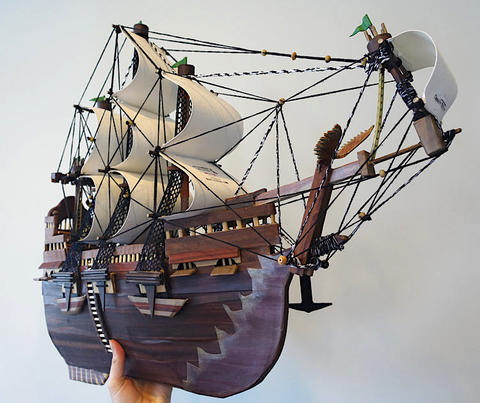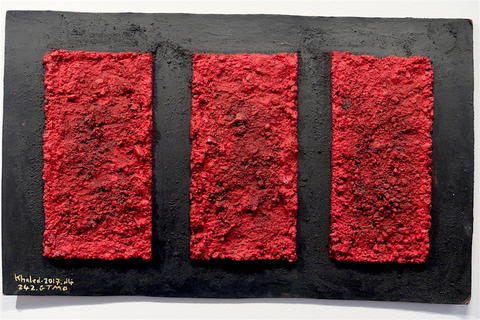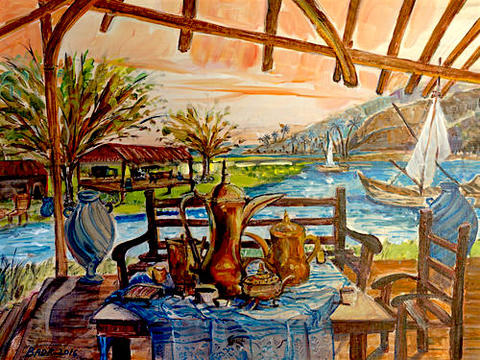The Powerful Artwork Still Being Created by Prisoners at Guantánamo, and the Outrageous Ban on its Dissemination That is Still in Place

A ship made entirely out of recycled materials by Guantánamo prisoner Moath al-Alwi.
If you can, please make a donation to support our work throughout the rest of 2022. If you can become a monthly sustainer, that will be particularly appreciated. Tick the box marked, "Make this a monthly donation," and insert the amount you wish to donate.
By Andy Worthington, August 31, 2022
Many thanks to BBC World reporter Joel Gunter for his recent detailed article, "The sudden silencing of Guantánamo's artists," about the wonderful artwork produced by some of the men held in the prison at Guantánamo Bay, a lifeline for them since they were first allowed to express themselves during the Obama presidency, but one that has become considerably compromised in recent years, after the Pentagon took exception to an exhibition of some of the prisoners’ artwork at John Jay College of Criminal Justice in New York City from October 2017 to January 2018.
"Ode to the Sea: Art from Guantánamo Bay" featured art by eight current and former prisoners, mostly innocuous scenes drawn from nature, all of which had been approved for release by the Pentagon after screening to assure officials that they didn’t contain hidden terrorist messages. Some of the artists showed noticeable talent, although the most striking works were ships and boats made by a Yemeni prisoner, Moath al-Alwi, using recycled materials.
I wrote at the time about the importance of prisoners being allowed to express themselves artistically after their long years of what was, fundamentally, profound isolation under President Bush, and of the importance of their art being allowed to be seen in the U.S., to show the men as human beings rather than the "super-terrorist" bogeymen that is the default position towards them that has been taken by the U.S. government and the mainstream media, even though the overwhelming majority of the 779 men held at Guantánamo since it first opened in January 2002 have never been charged with a crime, and were almost certainly nothing more than foot soldiers or even civilians seized by mistake.
I also did my best to amplify the outrage that greeted the news that, in response to the exhibition, the Pentagon would no longer allow prisoners to give their art to their lawyers, and to their families. The military claimed that their change of position was because the exhibition included an email address for people interested in buying artwork by the prisoners, ignoring the fact that it was only artwork by released prisoners that was for sale, and insisting that, in future, any prisoner who managed to secure release from the prison would not be allowed to take their artwork with them.
In January 2018, on my annual visit to the U.S. to call for the closure of Guantánamo on the anniversary of its opening, I visited the exhibition with friends and colleagues, noting how it "did nothing more shocking than daring to show that they [the prisoners] are human beings," and adding that, "Although the art program was triumphed by the military at Guantánamo for many years, with officials recognizing that it was good for the prisoners, and also good for the prison’s own blighted public relations, the sudden change of policy appears to be a return to the bad old days of hiding the prisoners away and keeping them silenced, which seems, moreover, to reflect a disconcerting clampdown on their status under Donald Trump."
Despite widespread criticism of the Pentagon’s position, the ban remained in place, and, shorn of an outlet for their creativity, many of the artists apparently gave up producing art, or reduced their output significantly. Shelby Sullivan-Bennis, an attorney representing three of the men still held, told Hyperallergic that her clients "were devastated to hear that their art couldn’t leave the prison. For some, that was its express purpose. For others, they realized the importance of its outside recognition only once it was taken away." She added, "Of my three clients, only one continues to attend art class, and it’s intermittently."
The 2020 exhibition, and Mansoor Adayfi
Two years later, in January 2020, I caught up with Shelby at the Sorensen Center for International Peace and Justice at CUNY (City University of New York) School of Law, based in Long Island City in Queens, where another, larger exhibition of the prisoners’ artwork — "Guantánamo [Un]Censored: Art from Inside the Prison" — was about to open to the public.
Marveling once more at Moath al-Alwi’s extraordinary ships and boats, I was also particularly struck by the artwork of Khalid Qasim (aka Khaled Qassim), another Yemeni, who, as I described it at the time, made pieces that were, "quite literally, made of Guantánamo, consisting of gravel collected by Khalid from the prison’s recreation yard, mixed with broken-up MRE (Meals-Ready-to-Eat) boxes, and then glued in place," as well as "more classical paintings, heavily covered with primer so that they look like Renaissance paintings, showing symbolic or allegorical scenes relating to imprisonment."

Artwork by Guantánamo prisoner Khalid Qasim, using gravel from the prison's recreation yard, paint and glue, representing the three men who died at Guantánamo in June 2006.
I wasn’t able to attend the official launch of the exhibition, in February 2020, but I wrote about it here, and Shelby explained to me in an email that "the objective — of the entire exhibition — is to provide a platform for the men to be heard, on their own terms, rather than through the words of others, and to combat the purposeful silencing and identity-erasure that GTMO perpetrates." As she also stated, since the clampdown that followed the 2017 exhibition, most of the prisoners stopped making art, so "part of the purpose of our event is to facilitate their being heard and to inspire them to start making art again."
Soon after the launch, unfortunately, Covid struck, adding to the isolation felt by the remaining prisoners under Donald Trump, who had already effectively sealed the prison shut, refusing to release any prisoners, except one Saudi, whose transfer to ongoing imprisonment in his homeland had been agreed to in a plea deal in his military commission trial before Trump took office.
As a result, the story of the prisoners’ art largely disappeared from view, and was only revived, after Joe Biden took office in January 2021, when the extraordinary flowering of artistic creativity under President Obama was highlighted by former prisoner Mansoor Adayfi, who had written the introduction to the John Jay exhibition, in his compelling memoir, "Don’t Forget Us Here: Lost and Found at Guantánamo," which was published last August. As I explained after Mansoor and I took part in an online event in December, "for a brief period, the prisoners living communally in Camp 6 were allowed art classes, and ended up prolifically turning the prison block into a living art gallery."
Mansoor, held at Guantánamo for 14 years without charge or trial, was released in 2016, but, as a Yemeni, could not be repatriated because of the U.S. government’s security concerns about his homeland. Instead, he was resettled in Serbia, where, like many former prisoners resettled in third countries, he has largely discovered that he has only swapped one prison for another. Although free to communicate with the wider world online, he is prevented from traveling, and is regarded with suspicion by the Serbian authorities.
Earlier this year, Joel Gunter visited him, and subsequently wrote a penetrating article, "Life after Guantánamo: 'We are still in jail,'" about Mansoor’s plight, and that of other former prisoners resettled in third countries, which was published in June. Like a handful of mainstream media journalists over the years, Gunter has evidently been drawn in by the sweeping and many-faceted injustices of Guantánamo, leading to his latest article, which sheds much-needed new light on the story of the prisoners’ art.
The ban must be lifted
Since Joe Biden took office, the ban has not been lifted, but while this didn’t matter too much under Donald Trump, because of his aversion to releasing prisoners, under Biden some of Guantánamo’s artists have finally been approved for release by Periodic Review Boards, a parole-type review process established under President Obama, but which was made essentially toothless under Donald Trump.
Moath al-Alwi, Khalid Qasim and a Pakistani prisoner, Ahmed Rabbani — all prolific artists — are now part of a majority of the 36 men still held (21 men in total), who will be released whenever the State Department secures agreements with their home countries — or with third countries — to accept them from Guantánamo, and all are wondering, with some justification, whether they will be allowed to take their artwork with them, or whether the shameful ban imposed nearly five years ago will still stand.
Gunter began by focusing on Khalid Qasim, who was finally approved for release on July 19. As he explained, "His release order does not mean freedom, yet. It is merely the starting gun on a long process of resettlement that, going by previous resettlements, could take years. Where he will be sent, neither he nor his lawyers know."
However, as Gunter added, "While he waits, Qasim will paint. During his long detention, Qasim has created scores of intricate paintings and other artworks, from seascapes, to scenes of fire, to a series of lone candles that commemorate the men who died in Guantánamo."
Via his attorneys, Qasim said of his work, "This is my life. It was my life here," adding, "The easiest way to explain it is that it's a way of telling others about what I feel. It's a feeling I have. It's a part of me. I'm putting Guantánamo on canvas."
It is hugely reassuring to hear that Qasim is still painting, although that relief is profoundly undermined by the realization that, as Gunter described it, "when Qasim is transferred out of Guantánamo, in months or years, he will not, as things stand, be allowed to take his art. It will remain the property of the U.S. government, which may store or destroy it."
From Qasim’s perspective, the U.S. "[k]eeping his art in Guantánamo would be 'the same as keeping me here,'" as he described it, adding, "The art I made is me. If they keep my art here, my soul will stay here."
Gunter also explained that Moath al-Alwi, who was approved for release last December, has also continued to create his astonishing ships and boats. "Inside the walls of Guantánamo," he wrote, "Moath al-Alwi has finished a new ship. It is called Eagle King, and it is his biggest and most intricate yet, with anchors, decks, an array of masts and sails and an eagle atop the bow rigging with its wings spread wide."
As Gunter added, "Before Eagle King was complete, al-Alwi's biggest model was Giant. When he finished Giant's sails and fastened its rigging, 'the most beautiful thing happened,' al-Alwi said, in a conversation relayed by his lawyer. 'I felt as if I were in the middle of the ocean. I felt waves hitting the ship from every direction, and I felt I was rescuing myself.'"
As Gunter also explained, "As well as Eagle King, al-Alwi has completed work on another new boat, this one called Hope. No photographs of it exist, and his lawyer's descriptions of it in her notes have been classified. But al-Alwi was able to describe it in an unclassified phone call. It is smaller than his large galleons, he said. The colours are softer — pastels. He has drawn flowers and doves on the sails."
As al-Alwi described it, "Despite being in prison, I try as much as I can to get my soul out of prison, I live a different life when I am making art; it makes me live within my soul. It makes me feel free."
I genuinely find it disturbing that, over a year and a half since Joe Biden took office, the repressive attitude of the Trump administration towards the prisoners’ art has not been amended at all, and no work created since then has been allowed to be seen at all. As Gunter described it, "Until the end of 2017, Guantánamo detainees were allowed to take their art with them when they were released, or give it to their lawyers to take out. The artists could bring their work to meetings with their lawyers, who would submit it along with their meeting notes to a team which vetted it for classified material or national security issues. Artwork deemed sensitive — paintings depicting torture, for example, or hunger strikes — was not allowed out, but otherwise the work was given back to the lawyers to take away."
When it "became clear," under Trump, "that art was no longer being allowed out," there was no explanation. "Like lots of things in the world of Guantánamo," Gunter explained, "there was no official notification to the lawyers, no memo. Artwork was all of a sudden simply bounced back from the vetting team to the detainees."
Then, to make matters worse, "the vetters at Guantánamo began marking the descriptions of the art in the lawyers' notes as classified," as Gunter put it. Mark Maher, one of Khalid Qasim’s attorneys, stated, "Now they are not even allowed to bring the art to the meetings. It's very frustrating for the men."
"In response," as Gunter added, "four lawyers penned a letter to military officials asking for the ban to be overturned — pointing out that convicted U.S. state and federal prisoners were permitted to make, send out, exhibit and sell their art. The lawyers got no reply."
As Maher described it, "If they have a reason I would love to hear it. I don't know what the justification could be for not allowing this art out into the world. We have requested that the men be allowed to leave with it, and the response we've had has been silence."
Approached by the BBC, the Pentagon stated only that the prisoners’ art was "considered the property of the U.S. Government and, as such, will remain in the custody of the JTF [Joint Task Force — which runs the prison] at the Guantánamo Bay detention facility."
As Gunter proceeded to explain, since the ban was put in place, only one prisoner "has been able to leave the prison with his art," with the ban "waived for Ahmed al-Darbi — a confessed al-Qaeda member [and the only prisoner released under Donald Trump] — in exchange for his co-operation testifying," as the Pentagon stated at the time.
Both Erin Thompson, a professor of art crime at John Jay College, and one of the curators of the original exhibition, and Beth Jacob, al-Alwi’s attorney, questioned "why the authorities would be concerned about former detainees making money," as Gunter described it, adding, "The whole idea was that the men were supposed to start supporting themselves after release." As Jacob said, "If a guy gets a job, are they worried about him making money? If a guy sells a picture, isn't that a plus?"
A letter to President Biden
In response to the current scenario, whereby the prisoners "are still allowed to make art," but "cannot show it or keep it," a group of former prisoners, as Gunter noted, "is preparing to publish an open letter on their behalf to the U.S. president, Joe Biden, asking him to overturn the Trump-era ban."
As the letter will explain, "Art helped us to survive at Guantánamo, to overcome the hardship and difficulties. It was our only escape from the prison's pain and loneliness. We painted the sea, trees, the blue sky, ships, we painted our hope, fear, dreams, and our freedom."
As Gunter also explained, the prisoners "have the support of various artists and curators." The acclaimed artist Laurie Anderson, who, in 2015, "beamed in, live, a giant 3D projection of former Guantánamo child prisoner Mohammed el-Gharani" into a gallery in New York, told the BBC, "It makes a huge difference if the public understands that these men are poets, painters, writers, thinkers, that they are people."
She added, "They have experienced great suffering and they have processed that suffering and found a way to express it. And it benefits the American public to see that."

A painting by Ahmed Rabbani.
In Guantánamo, meanwhile, as Gunter also explained, "the ban has had a discouraging effect on the artists," according to Ahmed Rabbani, who was approved for release last October. "Before the rule changed, I would make one piece a week, sometimes more than one a week," he said, adding, "Now when I create a new piece, I get disappointed and discouraged. If I can't take it with me, why make it?"
Rabbani was described by Gunter as "a skilled painter who has painted vivid scenes of tea settings with no people present — scenes he can populate in his imagination with his absent friends and family. Sometimes there are empty plates, references maybe to his hunger strike protests against torture. And, of course, he has painted the sea."
Gunter also explained how Moath al-Alwi "has recently begun to paint too. He has created a series of four pieces he calls The Story of My Imprisonment. No one outside the prison has seen them, but he described them over the phone. He said he had painted a man standing alone on a beach, through various phases of his life, as the moon rose and fell. By the third painting, the man had died. In the fourth, a boat finally arrived at the shore."
As al-Alwi explained, "When the boat came, they did not find the man, but they saw the tomb and put some flowers next to it. They left a note that it was too late."
Al-Alwi’s unseen artwork is a reminder of how necessary it is for the Biden administration to actually free the 21 men it is still holding who have been approved for release, while also serving as a vivid reminder that, when these men are released, their hopes, dreams and fears, committed to canvas or sculpted into towering ships, must also be allowed to leave with them.




